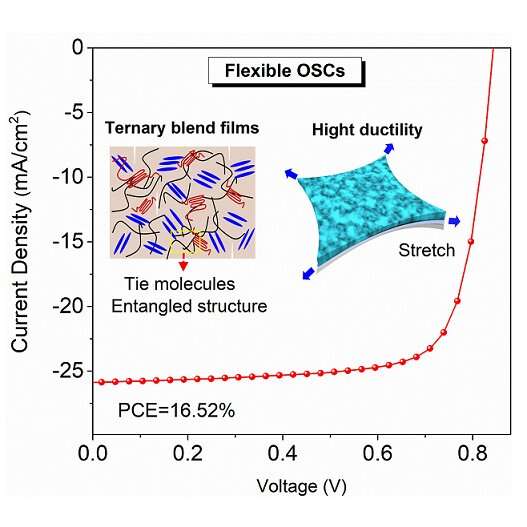Efficient flexible organic solar cells developed with excellent mechanical ductility

A research group led by Prof. Ge Ziyi at the Ningbo Institute of Materials Technology and Engineering (NIMTE) of the Chinese Academy of Sciences (CAS) has developed high-performance flexible organic solar cells (OSCs) with excellent thermal stability and stretchability, achieving power conversion efficiency efficiencies (PCE) of over 16.5%. Relevant results were published in Matter.
As a promising power source for wearable electronic systems, such as electronic textiles and soft robotics, etc., flexible OSCs have attracted great attention due to their good robustness and compatibility. However, reconciling high PCE, reasonable stretchability and thermal stability in one integrated device is a grand challenge.
In this study, the researchers at NIMTE incorporated polymer guests into the PM6:BTP-eC9 blend film to form entangled chain networks, thus improved the ductility and morphologically stability of the blend film.
Due to the effective dissipation of local load caused by the entangled structure, the crack-onset strain of the developed ternary blend membrane is 17.14% higher than that of the traditional binary blend membrane.
In addition, a stabilized PCE of 16.52% was obtained for the polyethylene terephthalate-substrate-based flexible OSCs with excellent bending tolerance, thanks to the ternary heterojunction strategy.
When stored in a N2-filled glove box at 85 °C, the PCE of the inverted ternary OSCs maintained over 85.5% (about 7.2% higher than the binary system) of its initial efficiency after 250 hours, indicating impressive thermal stability.
Moreover, the ternary OSCs showed excellent stretchability, which maintained PCE retention of over 88% (about 13% higher than that of the binary system) after 200 stretching cycles under a tensile strain of about 5%.
This study may shed light on the development and fabrication of high-ductility flexible OSCs by virtue of the structure morphology tuning.
More information: Wei Song et al, Entangled structure morphology by polymer guest enabling mechanically robust organic solar cells with efficiencies of over 16.5%, Matter (2022). DOI: 10.1016/j.matt.2022.03.012


















